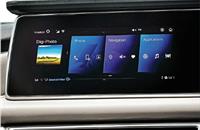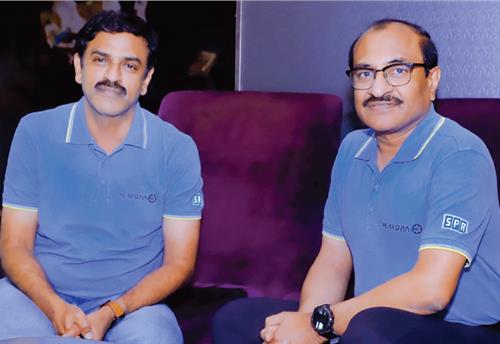‘We are working on 48-inch wide displays’
As car displays keep getting bigger, Sachin Lawande, president and CEO of Visteon believes that there are intrinsic drivers of the trend.
Big, bigger biggest…..yes that’s literally the transformation that the car infotainment screen is going through. If there is one aspect of a car’s interior that calls for attention, it is the display screen. Pretty much the way that cell phones evolved, you can see a distinct trend in the way these screens are expanding their girth.
Sachin Lawande, president and CEO of Visteon says there are “some intrinsic drivers that are driving this trend of larger screens in the automotive industry.”
It goes without saying that often we see the luxury OEMs leading the pack in terms of setting these trends and that’s because of the “desire to differentiate themselves from maybe the mass-market producers,” explains Lawande. He goes on to elaborate how Visteon is “working on 48-inch-wide displays, pretty much pillarto-pillar,” and added that there are new terms that are making their way into the automobile lexicon. A Driver Information Display or DID, a Centre Information Display or a CID and a Passenger Information Display or a PID are all indicators of this evolving trend.
The Visteon chief added that they have one business with Audi which will launch in a couple of years. and the company is a supplier to BMW also, “so, every BMW you see with a large screen comes from Visteon and we have also recently started a business with Mercedes-Benz. So, all three luxury brands will have 100 percent vehicles that come with our displays, which for Visteon, is a terrific development.”
One of the key reasons for the trend gaining momentum is undeniably the “success of ADAS,” says the Visteon chief. The fact that there is an expectation on the part of the OEMs driven by their experience with smartphones and tablets that they need to see the same kind of capabilities, user experience and quality inside the car. Primarily, these two factors are instrumental in making ‘big screens’ the in-thing even in vehicles that are perceived to be ‘value buys.’
But that’s not all. There is another piece that completes this jigsaw puzzle. Lawande highlights the fact that the third driver is the “popularity of Apple CarPlay and Android Auto – these are technologies that allow you to project from your phone into the dash or the screen.” Decidedly these two applications also have been pushing the boundaries and “mandating a certain size and resolution of the screens” and that in turn is necessitating the increase in the display sizes.

Visteon opened a new technical centre in Goa. This centre will contribute to the development of advanced technologies in Android-based infotainment, AUTOSAR, driver awareness systems, and autonomous vehicle solutions.
This enables displaying more information in a less distracting way to the driver and bringing down the associated risks. “As soon as one OEM decides to introduce vehicles with larger displays, it immediately makes the products from other OEMs look like they are outdated,’’ Lawande pointed out while explaining why a 10-inch screen is going to be the standard going forward.
Voice is the future
However, it is not only about bigger screens. In fact, when Tata Motors presented its Avinya concept, the company made it quite clear that it believes that voice, and not screens, will be the future of the automobile interior. The Visteon head agrees saying, “Voice is becoming a very credible solution. You’re not having an evening conversation with the car; you are commanding it to do things. So, there is a limit to the range of options for you, which is actually helpful in improving the accuracy.”

Visteon’s DriveCore technology uses artificial intelligence for object detection and tracking, situational analysis and driver-behaviour planning to enable ADAS-related features.
According to Lawande, Visteon is also invested heavily in voice activation and its collaboration with Mahindra — where it also supplied the large twin screens — is an example of advanced voice control. “To enable the shift to voice, you cannot do it with ECU architectures of today,” he says. “The processing demands on that require a shift to a different architecture, ethernet based and more processing capabilities — like SmartCore on the XUV700 — and you can see it offers a lot of voice capability, and it’s also very accurate.” So, while screens will certainly be a major aspect of a car’s interiors, in the long run, voice control, which is getting more and more accurate thanks to Artificial Intelligence (AI) could emerge as the dominant vehicle interface with screens playing a supporting role. Thus, in the future, we’ll likely be having more conversations with our vehicles rather than touch interactions.
This feature was first published in Autocar Professional's July 1, 2022 issue
Also see
In Conversation with Visteon's Sachin Lawande
Sachin Lawande: 'Every second car in India to feature touchscreen'
RELATED ARTICLES
BRANDED CONTENT: Eliminating the worries of battery charging with smart solutions
The charging infrastructure is the backbone of electric mobility but is also one of the key perceived barriers to EV ado...
The battery-powered disruptor
Greenfuel Energy Solutions is planning to shake up the EV battery market with the launch of a portfolio of specially eng...
SPR Engenious drives diversification at Shriram Pistons & Rings
The engine component maker is now expanding its business with the manufacturing of motors and controllers through its wh...





 05 Jul 2022
05 Jul 2022
 4543 Views
4543 Views








 Autocar Pro News Desk
Autocar Pro News Desk




